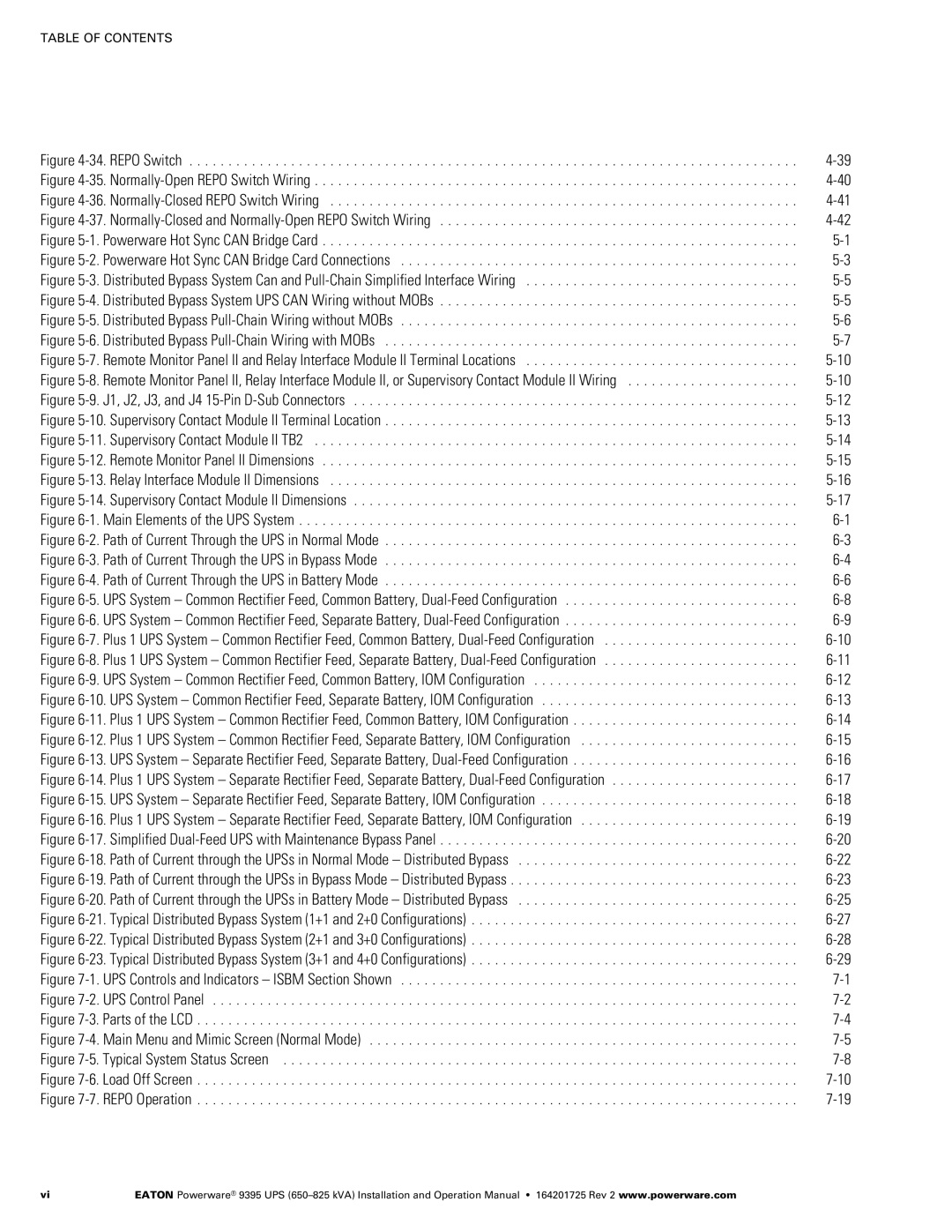Figure 4-34. REPO Switch | 4−39 |
Figure 4-35. Normally−Open REPO Switch Wiring | 4−40 |
Figure 4-36. Normally-Closed REPO Switch Wiring | 4−41 |
Figure 4-37. Normally-Closed and Normally-Open REPO Switch Wiring | 4−42 |
Figure 5-1. Powerware Hot Sync CAN Bridge Card | 5−1 |
Figure 5-2. Powerware Hot Sync CAN Bridge Card Connections | 5−3 |
Figure 5-3. Distributed Bypass System Can and Pull−Chain Simplified Interface Wiring | 5−5 |
Figure 5-4. Distributed Bypass System UPS CAN Wiring without MOBs | 5−5 |
Figure 5-5. Distributed Bypass Pull−Chain Wiring without MOBs | 5−6 |
Figure 5-6. Distributed Bypass Pull−Chain Wiring with MOBs | 5−7 |
Figure 5-7. Remote Monitor Panel II and Relay Interface Module II Terminal Locations | 5−10 |
Figure 5-8. Remote Monitor Panel II, Relay Interface Module II, or Supervisory Contact Module II Wiring | 5−10 |
Figure 5-9. J1, J2, J3, and J4 15−Pin D−Sub Connectors | 5−12 |
Figure 5-10. Supervisory Contact Module II Terminal Location | 5−13 |
Figure 5-11. Supervisory Contact Module II TB2 | 5−14 |
Figure 5-12. Remote Monitor Panel II Dimensions | 5−15 |
Figure 5-13. Relay Interface Module II Dimensions | 5−16 |
Figure 5-14. Supervisory Contact Module II Dimensions | 5−17 |
Figure 6-1. Main Elements of the UPS System | 6−1 |
Figure 6-2. Path of Current Through the UPS in Normal Mode | 6−3 |
Figure 6-3. Path of Current Through the UPS in Bypass Mode | 6−4 |
Figure 6-4. Path of Current Through the UPS in Battery Mode | 6−6 |
Figure 6-5. UPS System – Common Rectifier Feed, Common Battery, Dual-Feed Configuration | 6−8 |
Figure 6-6. UPS System – Common Rectifier Feed, Separate Battery, Dual-Feed Configuration | 6−9 |
Figure 6-7. Plus 1 UPS System – Common Rectifier Feed, Common Battery, Dual-Feed Configuration | 6−10 |
Figure 6-8. Plus 1 UPS System – Common Rectifier Feed, Separate Battery, Dual-Feed Configuration | 6−11 |
Figure 6-9. UPS System – Common Rectifier Feed, Common Battery, IOM Configuration | 6−12 |
Figure 6-10. UPS System – Common Rectifier Feed, Separate Battery, IOM Configuration | 6−13 |
Figure 6-11. Plus 1 UPS System – Common Rectifier Feed, Common Battery, IOM Configuration | 6−14 |
Figure 6-12. Plus 1 UPS System – Common Rectifier Feed, Separate Battery, IOM Configuration | 6−15 |
Figure 6-13. UPS System – Separate Rectifier Feed, Separate Battery, Dual-Feed Configuration | 6−16 |
Figure 6-14. Plus 1 UPS System – Separate Rectifier Feed, Separate Battery, Dual-Feed Configuration | 6−17 |
Figure 6-15. UPS System – Separate Rectifier Feed, Separate Battery, IOM Configuration | 6−18 |
Figure 6-16. Plus 1 UPS System – Separate Rectifier Feed, Separate Battery, IOM Configuration | 6−19 |
Figure 6-17. Simplified Dual−Feed UPS with Maintenance Bypass Panel | 6−20 |
Figure 6-18. Path of Current through the UPSs in Normal Mode – Distributed Bypass | 6−22 |
Figure 6-19. Path of Current through the UPSs in Bypass Mode – Distributed Bypass | 6−23 |
Figure 6-20. Path of Current through the UPSs in Battery Mode – Distributed Bypass | 6−25 |
Figure 6-21. Typical Distributed Bypass System (1+1 and 2+0 Configurations) | 6−27 |
Figure 6-22. Typical Distributed Bypass System (2+1 and 3+0 Configurations) | 6−28 |
Figure 6-23. Typical Distributed Bypass System (3+1 and 4+0 Configurations) | 6−29 |
Figure 7-1. UPS Controls and Indicators – ISBM Section Shown | 7−1 |
Figure 7-2. UPS Control Panel | 7−2 |
Figure 7-3. Parts of the LCD | 7−4 |
Figure 7-4. Main Menu and Mimic Screen (Normal Mode) | 7−5 |
Figure 7-5. Typical System Status Screen | 7−8 |
Figure 7-6. Load Off Screen | 7−10 |
Figure 7-7. REPO Operation | 7−19 |
